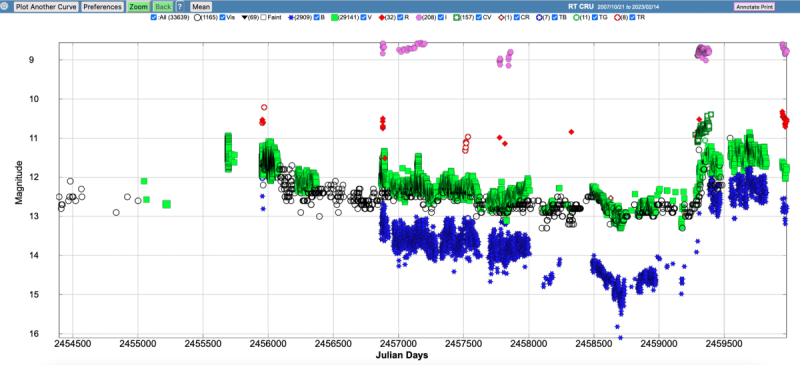February 10, 2023
AAVSO Forum threads (scroll to the bottom of a thread for latest posts):
- Campaigns & Observation Reports: https://www.aavso.org/rt-cru-campaign-2023
- Novae: https://www.aavso.org/rt-cru-campaign-2023-01
Please subscribe to these threads if you are participating in the campaign so you may be updated by the astronomers and by HQ. Join in the discussion or ask questions there!
Drs. Frederick Walter (Stony Brook University) and Juan Luna (Instituto de Astronomía y Física del Espacio) have requested AAVSO observers' assistance in monitoring the symbiotic nova RT Cru in support of XMM + NuStar observations scheduled for 2023 February 20/21 UT.
Dr. Walter writes: "RT Cru is decaying from a recent 1-2 year-long maximum, presumably near periastron in an elliptical orbit, during which the accretion onto the white dwarf from the red giant wind is enhanced. We are continuing to obtain spectra in an attempt to map out the orbit (the period is probably about 10 years), and will get some high time resolution photometry to look for flickering.
"Our request is for BVRI photometry to continue the good AAVSO light curve at least through the end of month. The cadence should be at least once per night, with a faster cadence (hourly if possible) the nights of Feb 20 and Feb 21. B and V are most useful - we're interested in the heating of the red giant by the hot white dwarf. There is a record of R and I in the most recent AAVSO data, so it would be good to continue that if possible, but they don't change much. CV is not particularly useful." Visual observations are welcome to supplement the light curve.
The most recent AAVSO data show RT Cru about half a mag below last year's maximum, and well above the quiescent level (2023 Feb. 4.79424 UT, 11.803 V +/- 0.004; Feb 4.79362, 12.8 B +/- 0.01, A. Pearce, Nedlands, W. Australia). The light curve below of RT Cru from the AAVSO International Database (generated via the AAVSO Light Curve Generator at https://www.aavso.org/LCGv2/ ) shows its behavior since late 2007. RT Cru has a range of 10.9 - 13.3 V.

AAVSO light curve of RT Cru for October 2007 - February 2023 (JD 2454395-2459990).
Please observe RT Cru through the end of March. The current campaign is focused on support for the satellite observations, but there will likely be future campaigns over the next decade to monitor RT Cru during the orbit study Dr. Walter mentions. If your observing schedule permits, please observe it on a regular basis to help continue to build the multicolor light curve in the AAVSO International Database.
Coordinates (J2000): R.A. 12 34 53.74 Dec. -64 33 56.1 (from VSX entry for RT Cru)
Charts with comparison stars for RT Cru may be created using the AAVSO Variable Star Plotter (VSP).
Please report observations to the AAVSO International Database using the name RT CRU.
Note that RT Cru is also the target of a campaign announced in AAVSO Alert Notice 503 and which has been running since 2014.
This Alert Notice was compiled by Elizabeth O. Waagen using information provided by Dr. Walter.
---------------------------------------------------
SUBMIT OBSERVATIONS TO THE AAVSO
Information on submitting observations to the AAVSO may be found at:
- Photometry/visual observations: https://www.aavso.org/webobs
- Spectroscopy: https://www.aavso.org/apps/avspec/
ALERT NOTICE ARCHIVE AND SUBSCRIPTION INFORMATION
An Alert Notice archive is available at the following URL:
https://www.aavso.org/aavso-alert-notices-for-observing-campaigns-and-discoveries
Subscribing and Unsubscribing may be done at the following URL:
https://www.aavso.org/aavso-alert-notice-subscribe
-------------------------------------------------
Please support the AAVSO and its mission -- Join or donate today:
https://www.aavso.org/apps/join-aavso

